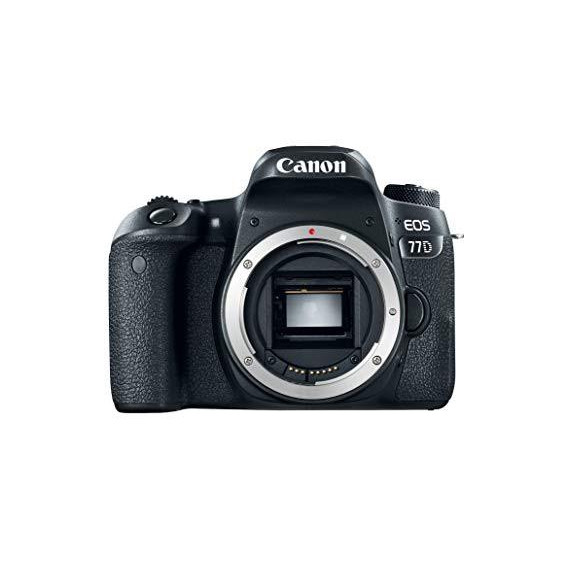P.K. Frary
I planned to buy a Rebel SL2 or T7i as a backup to my 80D but, with the Spring Canon rebate offer, the Canon EOS 77D dropped a Benjamin below the T7i. A week later I found a 77D on my doorstep. The 77D is essentially a cross between a Rebel and 80D: Rebel T7i form factor and build with many controls and features of the 80D. While not as solid as the 80D, the 77D feels good in my medium sized hands, sporting ample grip area and thoughtfully placed controls. Controls may be used by feel while looking through the viewfinder, allowing on the fly adjustments. The touchscreen is vivid, sensitive, and a dream for navigating through the menus. The only negative is the on-off switch: stiff and cheap feeling. Luckily I rarely turn my cameras off—sleep mode is good enough—but I felt like I might break the darn thing off with each use. AF is fast and accurate, basically the same as the 80D. The 45-point phase-detect AF system (viewfinder) covers a major portion of the frame, making off-center and low light compositions a snap. There are few situations this camera won’t achieve focus under. Canon’s AF mode and point selection are refined, fast and easy to use. I normally manually select zones and individual AF points while looking through the viewfinder: press the AF select button and spin one of the dials or press the rocker pad. AF points may be selected on the touchscreen also: move your eye away from the viewfinder and the AF modes instantly appear on the LCD. Dual Pixel AF, used for Live View and video, is amazingly flexible, accurate and several times faster than the Hybrid AF used on the prior generation of Rebels, e.g., SL1 and T6i, and M3. Simply press the Live View button and you have a highly effective “mirrorless” camera. I suspect the iOS generation will be perfectly happy using the 77D in Live View only, poking the touchscreen like a giant iPhone and uploading images to social media via Wi-Fi and the Canon Connect app. Dual Pixel AF is a level slower than the 45-point phase-detect AF in the viewfinder, so not for fast sports or birds in flight. However, it is ideal for point and shoot and can track joggers, walkers and crawlers like a champ. For video, it grabs faces like glue and never lets go. One significant feature the 77D didn’t inherit from the 80D is the 100% coverage and .95x viewfinder. Instead, we get a somewhat small and dim 95% coverage and .82x magnification Rebel spec viewfinder. Small viewfinders are par for the course for Rebels but disappointing for this class and price point. Although a wee viewfinder, its a “smart” one, featuring a transparent LCD overlay for display of AF points, grid and icons, aping EVF features. The square AF points are easy to see in most light, unlike the pinhole AF points used in many Rebel models, and may be programmed to flash red all the time, not at all or only in dim light. I leave the grid enabled to help keep horizontal and vertical lines square. Although an electronic level is available, it’s small and fiddly to use. Basic video options are yet another Rebel inheritance of the 77D. The good news is Dual Pixel AF is cutting edge by any standard and makes capturing sharp video shockingly easy. The quality of the resulting HD file is very good but, sadly, files are limited to low bit rates and the so-called “easy to share” MP4 format. In contrast, the 80D has the option of higher bit rates (MOV format and ALL-I compression), allowing for more post processing with fewer artifacts. And the 77D lacks clean HDMI out, so you can’t dance around the low bit rates with an external recorder. Another MIA 80D trait is auto focus micro-adjustment or AFMA: the ability to calibrate individual lenses for optimal sharpness. My 70D, 80D and 6D MK II required AFMA for most lenses. Oddly, my cameras without AFMA—SL1 and 77D—are sharp when using most of the same lenses. It’s as if Canon was intentionally sloppy setting up DSLRs with AFMA, expecting customers to calibrate, but dialed in those lacking AFMA more carefully. The diminutive LP-E17 is the same battery used in recent Rebels (T6i, T7i, etc.) and M-series EOS. A small battery is a necessary compromise for a small camera: don’t expect the same performance as a big battery like the LP-E6N. Canon claims the LP-E17 delivers 600 still images with optical viewfinder shooting and, indeed, I squeezed out close to that number. However, heavy Live View use drops that number below 300. In fairness, my M3 (mirrorless) uses the same battery and barely manages 200 frames, so the 77D is a reasonably power efficient camera in “mirrorless” mode. A spare battery is essential if you’ve got itchy trigger finger or shoot video. Finally, the image quality of the 77D is excellent: sharp, low noise, vivid colors, accurate exposure and noteworthy high ISO performance. No problem if you need a 2-stop shadow lift or a large print. I process RAW files in Adobe Lightroom Classic and the 77D exhibits the same image quality as the 80D, M5 and other cameras with the Canon 24.2 MP CMOS, so no surprises here. While not perfect, the 77D is a darn good camera: polished ergonomics, excellent AF performance and ready and able in nearly any photographic situation. It especially excels as a travel and hiking camera, shoehorning high performance into a compact form factor without being too tiny to hold comfortably. For video bloggers, the articulating LCD, Dual Pixel AF (in face priority mode) and smartphone control make the 77D a great choice for the next ramen challenge or makeup tutorial.


















